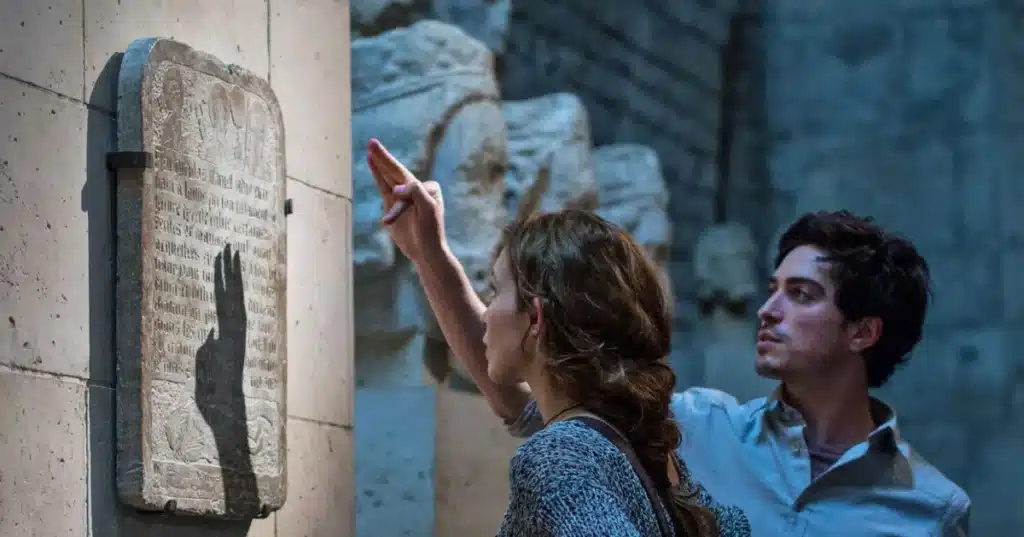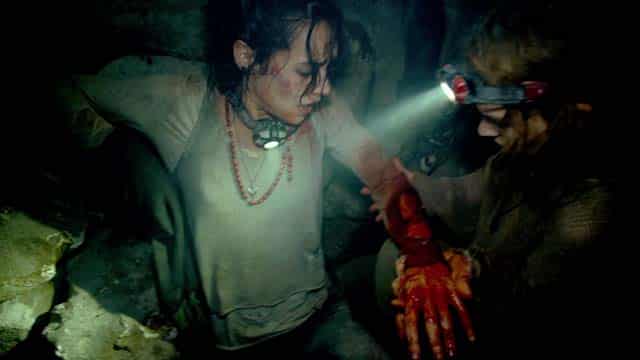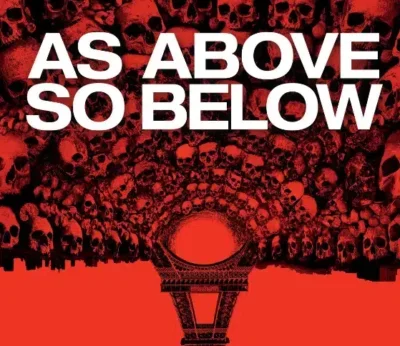As Above, So Below has a lot of potential in terms of its theme, concepts, and environment. What could possibly go wrong, after all, when you combine Dante’s Inferno, the Paris Catacombs, and an exciting tale of redemption? It turns out quite a bunch. Any good story must have strong characters, strong storytelling approaches, and most importantly, strong execution. Here’s how and why, despite having all the required resources, this film fell short of brilliance. Spoilers ahead for the As Above So Below plot and conclusion.
What does As Above So Below mean?
A young academic who is haunted by the death of her well-known archaeologist father is looking for the solution to unlock Nicholas Flamel’s Philosopher’s Stone. She quickly realises that the catacombs beneath Paris hold the key, so she collects her friends as well as some locals to assist her in her search. Soon after, strange occurrences begin, and the group finds itself in a state of genuine hell on Earth.
The environment is real, despite the fact that the film is not based on a true story. The Catacombs, which are located beneath Paris, are a vast area. Additionally, it’s believed that there are around 6 million graves there.
Since this is a found footage horror, it is only natural that they become disoriented and alone. This would have gone differently if they had a headquarters with fast fibre optic connection someplace in the subterranean. Unfortunately, the movie played into a stereotype.
From Above, Look Below| Plot Summary: Washing the Sins Away
Throughout the film, there are numerous allusions to Dante’s Inferno. The issue is that, morally, spiritually, and religiously speaking, the transgressions are also utterly unconvincing. In the end, it appears that this imagined hell is a location created to deceive individuals or aid them in overcoming trauma, which is not how it is intended to function.
What sin did George commit?
For instance, George feels bad for not being there in time when his brother drowned when he was still a youngster. Hell is not designed to punish people for feeling terrible about things that are simply not their fault. Being guilty of anything is not designed to guarantee eternal damnation. This implies that George’s sin is either being lost or not running quickly enough? Just… wow.

What sin does Scarlett have?
The same is true for Scarlett, who feels bad about not picking up the phone the night her father passed away. Does morality consider neglecting your parents to be “bad”? It is. Is it a terrible evil, though, to put your father’s calls on silent? It shouldn’t be, though. Once more, it makes perfect sense why she feels bad and that she won’t be able to move on until she forgives herself. It also provides the character with a great deal of motivation to continue on with this unrelenting drive. It is not, however, a fatal sin that is punishable by damnation.
What was the sin committed by Benji?
What’s Below Is As Above Some claim that he gives out some “lustful gazes” throughout the film, although there isn’t much evidence to support this. If Benji had sin, it wasn’t adequately depicted. If they did portray it, it wasn’t done sufficiently adequately.
Even when a mother and infant attack Benji, Zed’s sin was his refusal to accept custody of a child he knew to be his. It’s unclear what Benji’s sin was, though.
From Above, Look Below| Why did Siouxsie pass away?
What sin did Siouxsie commit?
Another component of the movie that is unclear is Siouxsie’s transgression. Siouxsie is killed before either she or the audience realises she has committed a sin and needs to repent.
From Above, Look Below| What sin did Papillion commit? Why did Papillion pass away?
It was meant to be his friend who was on fire, whom he abandoned to perish in order to save himself. Given that the way he died closely resembled a scenario from Dante’s Inferno, the manner of his death was significantly more significant.
No one is given an equal chance!
The notion that each of our protagonists has a sin for which they must confess is one of the key themes. Benji, the original videographer, and Siouxie, Pap’s lover, are two examples of characters that are killed off before they had a chance to show their regret. Before anyone in the film (or the audience) ever realises that this is the catacombs’ standard operating procedure, they are slaughtered. The only characters with true sins are Pap and Zed, although they receive a reprehensibly low amount of screen time in comparison to the others.
Deception Regarding Sins
One of the film’s main issues is that it has a very difficult time recognising or identifying the faults that it is punishing its protagonists for. Consider the emotion of greed. In one episode, Pap and Siouxie come across a big quantity of gold and nearly perish attempting to take it.
It is not wrong to desire to take something you see as gold. All spiritualists and philosophers teach against taking more than you need, always wanting more, and stealing from others. For instance, this scene would have been ideal if Benji (for example) got his leg stuck and Pap and Siouxie went after the gold instead of assisting him. We meant exactly this when we said there was a missed opportunity.
It’s not impossible for a popular cultural interpretation of a fantastical location to succeed. A pseudo-purgatory was handled remarkably well in The Lighthouse. Simply put, this film fell a little short.
From Above, Look Below| The stone’s composition. Stone of the Philosopher
The Philosopher’s Stone, another one of the film’s themes, is the primary MacGuffin. According to the narrative, it possesses a variety of magical abilities and is something that everyone wants to find. It was first suggested that it could transform any material into gold, extend life eternally, cure all diseases, etc., however the second half of the film lacks sufficient focus on this.
Don’t get us wrong; there are a tonne of instances where the MacGuffin excels as a vehicle for the plot. This is perfectly illustrated by the briefcase in Quentin Tarantino’s Pulp Fiction.
Who is the person sitting in the chair?
As Above, So Below features gargoyles as the monsters; at one point, we see a man seated on a wooden chair, which may or may not be a representation of Satan in this film. After all, Dante’s Inferno depicted him in this way.
Answers to Frequently Asked Questions
What does the phrase As Above, So Below mean?
According to the movie’s use of the word, their beliefs in the lower catacomb levels will come to pass.
Most likely, it means something like to Thy will be done, as it is in heaven. In other words, it’s a line from the hymn Our Father, which was chosen to represent the movie’s deep religious elements. This is what was said:
Outside of me is what is inside of me. Heaven is analogous to Earth in all respects. As I am, so are my atoms, my cells, and God. In essence, the world is how I perceive it to be.
What happened to La Taupe? As Above, So Below
La Taupe is meant to be their sinister, depraved interpretation of Virgil. They have their own demon guide, much as Dante had his.
From Above, Look Below: Why did the stone not function?

The movie’s abstract premise that ultimate power resides in our hearts rather than a tangible holy object is the reason why the stone didn’t work. She was able to work miracles only after accepting responsibility for her actions and making changes.
What followed was how Siouxie recovered?
Even the stone itself seems to possess some mystical qualities. It might, however, just be a ruse to lead the team astray.
After all, Siouxie’s death was inevitable, thus a higher power could have understood that her recovery would not have affected the outcome of the voyage. However, there’s also a chance that this is a major plot hole.
From Above, Look Below: Have they escaped?
Yes, it appears that they left. It’s possible that the opening they used to leave the catacombs was actually a doorway to another dimension.
The characters descend at one point in the film before rising again but reversed. From that point on, it appears that they were returning to the surface.
Who were the cultists and who was the girl in As Above, So Below?
Most likely, the girl is more of an omen (a lost spirit wandering between our plane of existence and the next). Cultists, on the other hand, may simply be fictitious representations of some of the most bizarre items found in remote areas of real catacombs. The truth is that there are too many storyline gaps in the film for any moment to have any significance.
Scarlett, the lead character, has problems.
The movie’s lead character might be the least impressive aspect. The epitome of a Mary Sue, Scarlett Marlowe is a character that constantly gains new abilities and is determined, brave, and courageous. This shouldn’t be too bad, in principle. After all, she was obviously intended to be a milder version of the popular strong female figure Lara Croft. However, the execution is where the issue is.
First off, rather than deduction, her brilliance frequently seems to resemble omniscience. For instance, she immediately understands that hell is 741 feet below the surface of the earth when she encounters the devil’s number, which is 741. Why the feet? Why not leagues, paces, yards, metres, miles, and kilometres? You get the idea.
Second, she frequently emphasises her skill by making everyone around her appear more incompetent rather than by demonstrating her own talent. Not to mention luck, which significantly influences how she is portrayed in the film. Vandalism is the action of removing a gravestone from a church wall and setting it ablaze with a match. The irony is that she consistently makes the proper guess, thus she gets away with it since she was right when she made the initial guess.
And last, she’s rude and self-centered, at least in the beginning of the movie. Although this is not a literary error, it does make it difficult to support her goal. She prods her claustrophobic friend George to accompany her to the tombs from the very beginning (since she might need him later). This is what a bad buddy is, to put it simply. It is also claimed that she had bailed out before leaving him in a Turkish prison. Sure, she later puts herself in danger to save him, but in all honesty, this is her single saving grace in the entire film.
Does Scarlett represent the stone?
Her reflection and the ability to heal George seem to suggest that this is the case. It’s uncertain if she had always been the stone or whether she changed into it in the catacombs. Since the movie ends so quickly, it’s difficult to draw any conclusions.
As a result,
In the end, the film isn’t awful. It’s just not impressive. The terrible thing is that it got a few things right, including the atmosphere and Scarlett’s redemption ark. Even yet, the result is not very excellent when weighing the good and the negative because it raises too many unanswered issues.
How did you feel about As Above, So Below? Please post a remark with your ideas.
ALSO READ THIS: TEN MOST ANTICIPATED FILMS OF 2023
